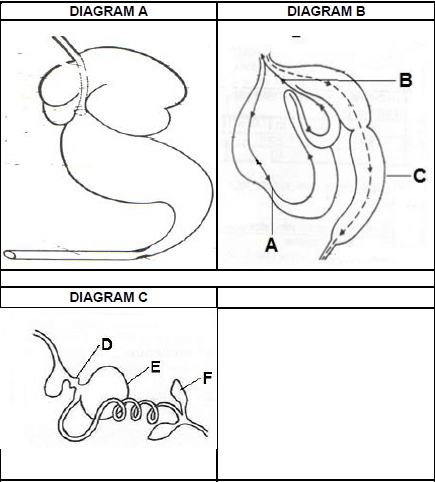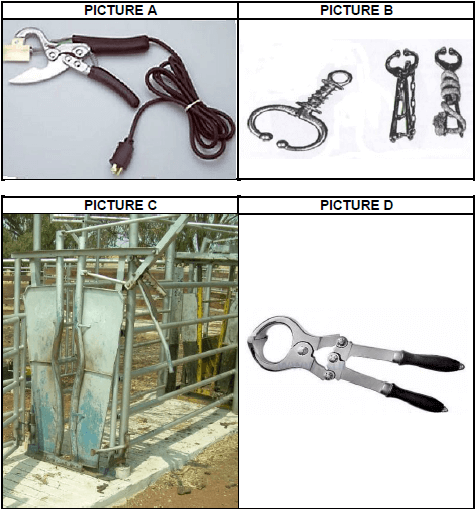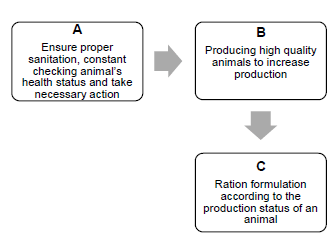Agricultural Sciences Paper 1 Grade 12 Questions - NSC Past Papers And Memos September 2020 Preparatory Examinations
Share via Whatsapp Join our WhatsApp Group Join our Telegram GroupINSTRUCTIONS AND INFORMATION
- Answer ALL the questions in the ANSWER BOOK.
- Start EACH question on a NEW page.
- Read ALL the questions correctly and answer only what is asked.
- Number the answers correctly according to the numbering system used in this question paper.
- You may use a non-programmable calculator.
- Show ALL calculations, including units and formulae, where applicable.
- Write neatly and legibly.
QUESTIONS
SECTION A
QUESTION 1
1.1 Various options are provided as possible answers to the following questions. Choose the answer and write only the letter (A–D) next to the question number (1.1.1–1.1.10) in the ANSWER BOOK, for example 1.1.11 A.
1.1.1 The stomach of a fowl where hydrochloric acid is secreted.
- Gizzard
- Proventriculus
- Reticulum
- Ventriculus
1.1.2 The movement of soluble food particles through the walls of intestines into the blood stream is …
- retention.
- ingestion.
- mastication.
- absorption.
1.1.3 The importance of emulsification during digestion involves:
- Increasing the surface area for effective activity of lipase
- Counteracting petrifaction
- Changing the pH of chime from alkaline to acidic
- Assisting in the absorption of fat-soluble vitamins
Choose the CORRECT combination:
- (i), (ii) and (iv)
- (i), (iii) and (iv)
- (i), (ii) and (iii)
- (ii), (iii) and (iv)
1.1.4 The metabolic energy of the feed is equal to the gross energy of feed, minus the energy lost in …
- manure, urine and body heat.
- gases, urine and body heat.
- manure, urine and gases.
- manure, gases and body heat.
1.1.5 The following equipment is important in poultry production except …
- drinkers.
- feeders.
- plywood boards.
- roosts.
1.1.6 In a commercial farming system, the following occurs:
- Output is targeted for the household consumption.
- Improved animal breeds and crop varieties are used.
- Profit is maximised by large-scale production.
- Modern technology is used.
Choose the CORRECT combination:
- (i), (iii) and (iv)
- (ii), (iii) and (iv)
- (i), (ii) and (iii)
- (i), (ii) and (iv)
1.1.7 An example of metabolic diseases affecting farm animals:
- Parakeratosis, goitre and anaemia
- Anaplasmosis and keratomalaise
- Lumpy wool, hypomagnesaemia and tetanus
- Osteomalacia, arthritis and coccidosis
1.1.8 The poisonous plant with a bad smell and taste commonly found in the veld:
- Maize fungus
- Yellow tulip
- Poison bulb
- Thorn apple
1.1.9 Visible signs shown by a cow that is about to give birth:
- Urinates and defecates frequently
- Distress and discomfort
- Isolates itself from the herd and stops eating
- Dripping of milk from teats due to the sucking of the calf
Choose the CORRECT combination:
- (i), (ii) and (iii)
- (ii), (iii) and (iv)
- (i), (iii) and (iv)
- (i), (ii) and (iv)
1.1.10 The membrane surrounding the foetus responsible for the elimination of waste products is the…
- umbilical cord.
- allantois.
- chorion.
- amnion. (10 x 2) (20)
1.2 Indicate whether each of the descriptions in COLUMN B apply to A ONLY, B ONLY, BOTH A AND B or NONE of the items in COLUMN A. Write A only, B only, both A and B or none next to the question number (1.2.1–1.2.5) in the ANSWER BOOK, for example 1.2.6 B only.
COLUMN A | COLUMN B | ||
1.2.1 | A: | Vitamin A | Deficiency causes brittleness and porousness of bones |
B: | Vitamin K | ||
1.2.2 | A: | High DP content | Suitable for growth, milk production and reproduction |
B: | Low fibre content | ||
1.2.3 | A: | Crush | Handling facility where animals are kept prior to handling |
B: | Holding pen | ||
1.2.4 | A: | Spraying | Administering medicine for the treatment of external parasites |
B: | Dosing | ||
1.2.5 | A: | Testosterone | Development of secondary masculine sexual characteristics |
B: | Oestrogen | ||
(5 x 2) (10)
1.3 Give ONE word/term for each of the following descriptions. Write only the word/term next to the question number (1.3.1–1.3.5) in the ANSWER BOOK.
1.3.1 The ration that provides enough nutrients to keep an animal alive and in good condition
1.3.2 The action taken by farmers to give animals immunity against diseases
1.3.3 The structure that develops on the ovary in place of a burst follicle
1.3.4 A powerful contraction of the urethra causing deposition of the semen into the vagina
1.3.5 The hormone in cows responsible for udder and milk production
(5 x 2) (10)
1.4 Change the UNDERLINED WORD(S) in each of the following statements to make them TRUE. Write only the answer next to the question number (1.4.1–1.4.5) in the ANSWER BOOK.
1.4.1 Volatile fatty acids are organic compounds forming the building blocks of protein and cannot be synthesized by animals.
1.4.2 Anthrax is a non-contagious bacterial disease that affects farm animals.
1.4.3 Pro-oestrus is the stage in the oestrus cycle when the corpus luteum is fully functional.
1.4.4 Seminal vesicle transports sperm cells from the epididymis to the urethra.
1.4.5 Abortion is the condition where the vagina protrudes beyond the vulva, leading to infection. (5 x 1) (5)
TOTAL SECTION A: 45
SECTION B
QUESTION 2: ANIMAL NUTRITION
Start this question on a NEW page.
2.1 The diagrams below shows the alimentary canal, stomach and process occurring in the stomach of a farm animal.
2.1.1 Indicate the ages of the animals with a stomach as in DIAGRAM A and DIAGRAM B. (2)
2.1.2 Give a reason visible in DIAGRAM A and DIAGRAM B to justify the answer to QUESTION 2.1.1. (2)
2.1.3 Identify the processes illustrated by arrow A and arrow B in DIAGRAM B. (2)
2.1.4 Explain the importance of the process illustrated by arrow B in digestion. (2)
2.1.5 State the difference of part F in DIAGRAM C with that of a pig. (1)
2.1.6 Identify the letter representing the stomach of the animal in DIAGRAM C that corresponds with part C in DIAGRAM B in terms of functioning. (1)
2.2 The table below shows the mineral deficiency symptoms, methods of supplementing and the types of animal affected.
Fill in the missing information A, B, C and D in the table.
MINERAL DEFICIENCY SYMPTOM | METHOD OF SUPPLEMENTATION | ANIMAL INFECTED |
A | Intravenous injection with calcium borogluconate | Dairy cows |
B | C | Pigs in cement pigsty |
Wasting disease | D | Cattle |
(4)
2.3 A farmer has two feeds available to use for compiling a balanced diet for lactating cows that need 16% digestible protein. The following information is the nutritional composition of these feeds.
COMPOSITION (%) | FEEDS | |
OAT MEAL | PEANUT OILCAKE MEAL | |
Carbohydrates | 56 | 25 |
Digestible protein | 8 | 36 |
TDN | 80 | 72 |
2.3.1 Classify the feeds in the table above. (1)
2.3.2 State TWO reasons why it is important to feed animals with the feed mentioned in QUESTION 2.3.1. (2)
2.3.3 Identify the feed from the table above that can have the following:
- Wide nutritive ratio (1)
- Narrow nutritive ratio (1)
2.3.4 Calculate the ratio required for each feed to get the 16% digestible protein needed for the lactating cows. (4)
2.4 The information below indicates the daily metabolic energy requirement for maintenance of cows as per live weight.
LIVE WEIGHT OF COW(G) | METABOLIC REQUIREMENT IN (MJ/DAY) |
350 | 15 |
400 | 23 |
450 | 35 |
500 | 45 |
550 | 50 |
600 | 65 |
2.4.1 Present the above information above in the form of a line graph. (6)
2.4.2 Deduce the trend of metabolic requirement per live weight of a cow. (2)
2.4.3 Calculate the metabolic energy requirement for the maintenance of a cow with a live weight of 400 kg in 5 days. (2)
2.4.4 Name TWO reasons why it is important to calculate the energy value of feed. (2)
[35]
QUESTION 3: ANIMAL PRODUCTION, PROTECTION AND CONTROL
Start this question on a NEW page.
3.1 The pictures below show tools/equipment/apparatus that are used when handling farm animals.
3.1.1 Identify the tool/equipment/apparatus that is suitable in each of the following operations:
- Restraining the animal during dehorning (1)
- Cannot be used to castrate lambs (1)
- Used to hold large animals (1)
- Bloodless apparatus used when docking/castrating animals (1)
3.1.2 Indicate how the following techniques can be used to hamper animals’ ability to walk during handling:
- Hobbling (1)
- Immobilising (1)
3.2 The illustration below shows the factors used to increase production on a farm.
3.2.1 Indicate the animal production system addressed by the factors in the above illustration. (1)
3.2.2 Identify the factors to increase production as illustrated in A, B and C. (3)
3.2.3 Name ONE factor to increase production which is not illustrated above. (1)
3.2.4 Indicate the way in which farmers can address the factor mentioned in QUESTION 3.2.3. (1)
3.3 Below are different ways in which animals behave:
- Wallow in the mud to cool down.
- Pawing the ground when aggressive.
- Pecking on all objects on the ground as possible food.
- Stay closer together while grazing or being herded.
3.3.1 Name the type of an animal that shows the behaviour in A, B, C and D. (4)
3.3.2 Indicate THREE signs displayed by the animal in QUESTION 3.3 A when it is under stress. (3)
3.4 The picture below shows the life cycle of a parasite that affects farm animals.
3.4.1 Classify the parasite in the above picture and give its name. (2)
3.4.2 Give the type of an animal that is susceptible to this parasite. (1)
3.4.3 Identify THREE stages of the life cycle of the parasite visible in the picture above. (3)
3.4.4 Name ONE precautionary measure that the farmer can put in place to prevent an infestation by the parasite. (1)
3.5 Below is a list of diseases commonly affecting farm animals.
| Bovine tuberculosis; heartwater; lumpy wool; redwater; coccidiosis; anaemia |
3.5.1 Select a disease from the list above that can be transmitted by each of the following methods:
- Transmitted by a bont tick
- Spores can be transmitted by contaminated shearing equipment
- Infected by ingesting eggs from feed contaminated with manure
- Transmitted through inhalation (4 x 1) (4)
3.5.2 Indicate the disease from the list above that is non-infectious. (1)
3.6 Indicate whether each of the following practices is the role of the state or the farmer in controlling diseases in farm animals:
3.6.1 Application of prescribed medication (1)
3.6.2 Importation of vaccines (1)
3.6.3 Ensuring proper sanitation in a milking parlour (1)
3.6.4 Export and import bans (1)
[35]
QUESTION 4: ANIMAL REPRODUCTION
Start this question on a NEW page.
4.1 The diagram below shows the reproductive system of a farm animal.
4.1.1 Identify the animal with the reproductive system shown in the diagram above. (1)
4.1.2 Give TWO reasons visible in the above diagram to support your answer to QUESTION 4.1.1. (2)
4.1.3 Identify the letter representing the part responsible for the following functions:
- Gametes are formed (1)
- Fusion of male and female gametes (1)
- Implantation of the embryo (1)
4.1.4 Name TWO hormones produced in the part labelled D. (2)
4.2 In animal reproduction the bull is necessary to produce the sperm cell to fertilise a cow. If the bull is unable to fertilise a cow, it may either be sterile or infertile.
4.2.1 Differentiate between sterility and infertility. (2)
4.2.2 Name TWO congenital defects that may lead to sterility in bulls. (2)
4.2.3 State TWO conditions that may cause the inability of a bull to copulate. (2)
4.3 Semen from the bull can be harvested, examined, diluted and stored for later use.
4.3.1 Name TWO requirements for semen collection. (2)
4.3.2 Indicate the main purpose of diluting the semen. (1)
4.3.3 The storage of semen has an advantage for the farmer. Justify this statement by giving TWO advantages. (2)
4.4 Cows with the proven heritable traits are used to produce embryos which are placed on less productive cows. Below are the steps involved during this process:
- A Foley catheter is used to recover the embryo
- Semen is placed into the reproductive tract of a cow
- Isolation and classification of the embryo
- Transfer of the embryo to the uterus of a cow
- Treatment of the cow with the gonadotropin hormone
4.4.1 Re-arrange the above steps to ensure that the process is carried out with success. (5)
4.4.2 Name TWO types of cows involved in the process. (2)
4.4.3 State TWO disadvantages of the process. (2)
4.5 The graph below shows a normal lactation curve of a dairy cow.
4.5.1 Identify the week when the cow reached her maximum production from the lactation curve above. (1)
4.5.2 Indicate TWO benefits of the milk produced within the first 3 days of parturition for the calf. (2)
4.5.3 Explain the relationship between the percentage of butter fat content, and quantity of milk produced as shown in the curve. (2)
4.5.4 Name the period in lactating cow that follows after 42 weeks. (1)
4.5.5 State the importance of this period for the cow. (1)
[35]
TOTAL SECTION B: 105
GRAND TOTAL: 150